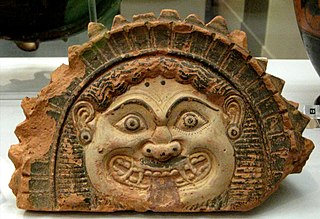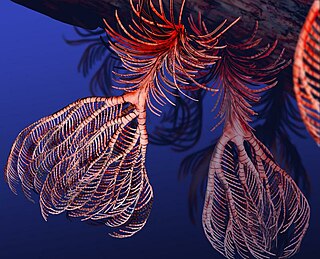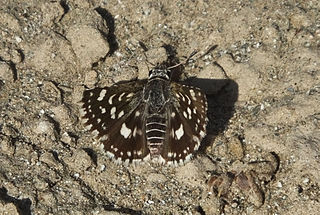
In Greek mythology, Medusa also called Gorgo, was one of the three monstrous Gorgons, generally described as winged human females with living venomous snakes in place of hair. Those who gazed into her eyes would turn to stone. Most sources describe her as the daughter of Phorcys and Ceto, although the author Hyginus makes her the daughter of Gorgon and Ceto.

Aprostocetus is a genus of hymenopteran insects of the family Eulophidae. The genus was erected by John O. Westwood in 1833. This very large group has a global distribution.

Pentacrinites is an extinct genus of crinoids that lived from the Hettangian to the Bathonian of Asia, Europe, North America, and New Zealand. Their stems are pentagonal to star-shaped in cross-section and are the most commonly preserved parts. Pentacrinites are commonly found in the Pentacrinites Bed of the Early Jurassic of Lyme Regis, Dorset, England. Pentacrinites can be recognized by the extensions all around the stem, which are long, unbranching, and of increasing length further down, the very small cup and 5 long freely branching arms.

Gorgonocephalus is a genus of marine basket stars in the class Ophiuroidea. Members of this genus are found in coldwater environments including the Arctic, the Antarctic, and deep-sea habitats. The scientific name comes from the Greek, gorgós meaning "dreaded" and -cephalus meaning "head", and refers to the similarity between these echinoids and the Gorgon's head from Greek myth with its coiled serpents for hair. The Greek mythological hero Perseus beheaded the Gorgon Medusa; when Perseus later dropped Medusa's head on the beach, her petrifying glance turned the nearby seaweed to stone, creating the first coral.

Spialia doris, the Aden skipper or desert grizzled skipper, is a butterfly of the family Hesperiidae. It is found in Morocco, Egypt, Saudi Arabia, United Arab Emirates, Somalia and India. In the Atlas mountains it is found at heights of 400 to 1,750 meters above sea-level.
The Macronyssidae are a family of parasitic mites in the order Mesostigmata.

Cynips is a genus of gall wasps in the tribe Cynipini, the oak gall wasps. One of the best known is the common oak gall wasp, which induces characteristic spherical galls about two centimeters wide on the undersides of oak leaves.

Macrochelidae is a family of mites in the order Mesostigmata, containing the following genera and species:
Neopodocinum is a genus of mites in the family Macrochelidae. There are about 10 described species in Neopodocinum.
In 1758, in the 10th edition of Systema Naturae, the Swedish scientist and taxonomist Carl Linnaeus described the class "Vermes" as:
Animals of slow motion, soft substance, able to increase their bulk and restore parts which have been destroyed, extremely tenacious of life, and the inhabitants of moist places. Many of them are without a distinct head, and most of them without feet. They are principally distinguished by their tentacles. By the Ancients they were not improperly called imperfect animals, as being destitute of ears, nose, head, eyes and legs; and are therefore totally distinct from Insects.
Discourella is a genus of mites in the order Mesostigmata, placed in its own family, Discourellidae.
Neopodocinum halimunensis is a species of mite in the family Macrochelidae.
Neopodocinum subjaspersi is a species of mite in the family Macrochelidae.
Neopodocinum vanderhammeni is a species of mite in the family Macrochelidae.






